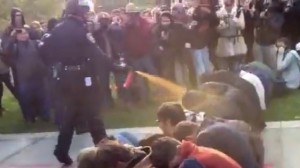 Chilling video images surfaced online today showing a campus police officer at the University of California, Davis, calmly pepper spraying the faces of Occupy Wall Street protesters seated quietly in a line with their arms interlocked. The images, captured with cellphones by several onlookers, quickly spread virally across the Internet.
Chilling video images surfaced online today showing a campus police officer at the University of California, Davis, calmly pepper spraying the faces of Occupy Wall Street protesters seated quietly in a line with their arms interlocked. The images, captured with cellphones by several onlookers, quickly spread virally across the Internet.
As unsettling as the video images are, the keyword for me in the news event is onlookers plural.
It reminded me of the ridiculous reprimand the Associated Press (AP) gave its staffers earlier this week for sending out breaking news over their Twitter accounts instead of saving it for the company’s traditional wire-service subscribers—even though the news in question was the arrest of AP staffers at the Occupy Wall Street protests in New York.
“In relation to AP staff being taken into custody at the Occupy Wall Street story, we’ve had a breakdown in staff sticking to policies around social media and everyone needs to get with their folks now to tell them to knock it off. We have had staff tweet – BEFORE THE MATERIAL WAS ON THE WIRE – that staff were arrested.”
With multiple people at major news events equipped with cell phones and Twitter, Facebook, and YouTube accounts, the AP faces a losing battle sitting on news until a full story can be written and published on its regular wire. A “wire first, tweet later” policy is just asking for citizen journalists to scoop the AP, making it a channel for stale news.
I haven’t seen any reports of Associated Press staffers covering the events at UC Davis. If they did, they would have been better served by the advice of the Interchange Project:
“There is nothing wrong with breaking news on Twitter and then sending out additional tweets with links to more info in the future. This doesn’t have to be an either-or proposition. Break the news on Twitter, write a short wire post and then send out another tweet with more info. Simple.”
Simple if you have dealt with reality and are willing to disseminate quickly on social media the best content you and citizen journalists produce.
Not so simple if you forgot breaking news to the public is job one.
Your turn? Do you think people will turn to the AP for news on major events if its stories are stale compared to the tweets, photos, Facebook updates, and videos citizen journalists post to social media? Is sitting on news in hopes of a scoop hours down the line in the best interests of the AP’s audience, the public?